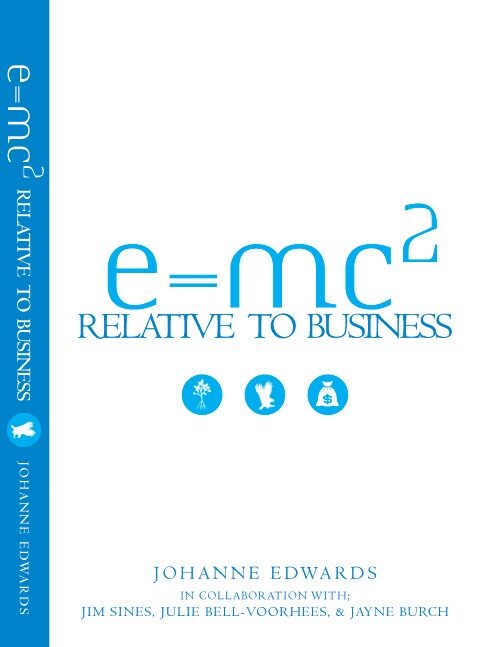Synopsis of the Book E=MC2 Relative to Business
How Would Einstein Run a Business?
By Johanne Edwards
In collaboration with Jim Sines, Julie Bell – Voorhees and Jayne Burch
The Eight Key Areas for Creating a Company that Creates:
- Design a new operating culture and climate that fosters the new behaviors that forwards creative expression.The old Industrial Age culture is fast on the decline and the new Knowledge Age culture is taking its place. This means that we need to examine the values and beliefs that we currently are hanging onto. We need to craft businesses to operate in the new value sets of the Knowledge Culture. Invention moved us from the Agricultural Age to the Industrial Age and invention is now moving us forward again. Businesses that do not recognize or make the shift will become extinct. The new Knowledge Age Culture fosters: mastery, life long learning, conservation, ethical behaviors and rewarding work and life experiences. This shift is leaving behind the old Industrial Age Cultural values of focusing on the clock or the time value, looking good and being right, bottom line numbers, short term fixes (which I call the old “hack and slash”), and entitlement. Shifting cultures will create a climate for innovation and risk taking and liberate employees to contribute their creative ideas. This will expand the creative capital of your organization.
- Create a clear vision and make the shift.Making the change means focusing on the future, not trying to fix and band aid the past. We need to reinvent ourselves. And this begins with a vision. This means understanding the difference between a Mission and a Vision. The course of action for the business can only be created by the leader. Then each staff area must create their vision in alignment with the leaders. Visioning is a difficult process, the process of inventing and crafting a business. This visioning process is where the leader comes to the edge and with a leap of faith begins realizing his/her dream. This is an area of high risk with limited sight with only the faith in one’s intuition to propel them forward. Many believe that the edge is facing the unknown. But it is also facing the known but unacknowledged. We cannot change what we do not acknowledge. Joseph Schumpeter, economist was one of the first to define what an entrepreneur was. He said that inventions where different from an entrepreneurs innovations. His thought was that entrepreneurs innovate by establishing new forms of organizational operation. This business innovation forwards invention. Like Einstein his theory was an innovation in defining the organization of the universe and it is from that definition that resulted in the many of the inventions that we realize today. Inventions like space travel, the satellite, the computer and even television are available because of E=MC2. Einstein derived his formula (vision) in 1906 just a scant 100 years ago.
- Grow the emotional competency of the leaders and ultimately their behaviors, this will forward positive relationship building. You can be a great entrepreneur but you cannot put your innovation into reality without the technology of relationship building, rapport and team. Therefore, the entrepreneur must raise his EQ. That is his Emotional Quotient. There is a new book on the market called Emotional Intelligence by Daniel Goleman. He talks about the success rates of a person with high EQ to be significantly greater then people with high IQ. There are actually seven intelligences of which the school system only teaches three. Emotional Intelligence is one of them. There are now instruments that can test for high EQ. One of the training topics that the author has added to her curriculum is a very advanced course in Emotional Intelligence. A much needed component for the Information Age and the Knowledge Culture if your business is going to flourish. The book E=MC2 talks about all the major components of emotional intelligence while defining each. They are: Coming from the Heart, Communicating Openly and Honestly, Confidence to Handle Confrontation, Clarifying and Discerning the Truth, Commitment to Be in it for the Long Haul, and a high level of Compassion and Empathy. The entrepreneur in the Knowledge Culture will need both the intelligence to run and design a business that creates and a collaborative relationship building intellect.
- Model the new behaviors. Help the employees learn to express their creative selves. One of the major problems in business today is that the leaders are out of congruence. In other words they don’t walk the talk. They say one thing while doing something else. As Mahatma Gandhi put it; “you must be the change you want to see in the world.” This infectious behavioral modeling must be an articulation of the value sets of the company. He/she is personally responsible for validating what leadership looks like. This is a must in order to create rewarding and enriching job environment. The leader is not only an innovator of a business he is also the crafter of a rewarding, enriching work experience. To craft the experience means: * changing beliefs and perceptions * mobilizing employees in alignment with the vision * inspiring new thinking with encouragement * getting things rolling * taking the handcuffs off employees and letting them experiment * help employees overcome their fears * let your employees know that they are part of something significant * let them know that what they do matters * challenge and making them stretch * get the employees involved and excited * honor and respect their creativity and then reward the employees that operate in the new way.
- Shift the authority to the employees so that they can begin to initiate their creative ideas and implement solutions that reward the new behaviors. This will engage the employees into an exceptional work experience. Create creative problem solvers instead of problem finders. In the creative Knowledge Culture it will be up to the employees to outgrow their need for an authority figure and to become their own authority. The one thing about Autocratic leadership is this “the more you control, the less you control and then you go out of control.” Not Autocratic or Democratic but what the author has coined as Initioacratic; where the employees take the initiative to solve the thousands of problems that business faces today. The leader needs to learn to ask questions instead of having all the answers to force the authority back to the people who do the work. And he/she must stop assessing blame. The boss needs to begin to share information and create self directed teams and encourage the risk taking of their employees.
- Measure the leader’s impact on the creative capital. High levels of emotional intelligence build trust and reduce stress. Employee well being measurements along with budget and efficiency will create a better balance and higher profits. This has leaders looking at all the costs of doing business. Not just efficiency and budget measures, consider adding employee well being as a measurement for success and cost containment. Measurement areas such as health care utilization rates, employee turn over rates, injury rates (studies show that high stress increases accidents), employee litigation costs, and stress related illness can help determine if a leader is creating high levels of unhealthy stress. This can be a measure and an indicator of the true cost. It has been documented in some Industrial Age Culture businesses that the greatest utilization of health care benefits has been for therapy. Dynamic change can only occur when the emotional maturity level of the organization as a whole will allow it. As we mentioned before, here are emotional competency testing that can evaluate if the leader is growing in the area of his EQ. This would also be an indicator as to the leader’s impact on the creative human capital under his direction. The new leader will embrace becoming a coach and a mentor versus being the boss who was always right. In other words craft the business that forwards rewarding and creative experiences for the employees. Transaction economics is discussed in this chapter.
- Create an organizational structure that will bring into play a more effective team approach to problem solving. Create the MC2 problem solving team structure. There are four steps to integrating a cost saving problem solving structure within your organization:
- Empower the leader of the facilitators of MC2 with authority
- Select the right leader with high EQ who can encourage employees to take risks and take the initiative to act on what he knows
- Select the target area for problem solving and cost containment
- Create an investigative network in the area targeted for improvement
It will be up to the leader to establish the objectives, measurements and to be an agent for overcoming obstacles. He will also want to establish a conservation ethic for the team facilitators and the targeted areas for change.
- Create a methodical problem-solving system that will generate, evaluate, and implement the new and cost prudent ideas. The problem solving method is a five-phase approach to problem solving. It is a guided approach that gives the team a structure for making changes happen. Einstein said that “creativity can be planned.” And it can. The steps are:
· definition phase
· creative phase
· evaluation phase
· implementation phase
· follow up phase
Instead of the old “hack and slash” budget cut approach used in the Industrial Age culture, true problem-solving is a detailed step- by- step process. The process builds teams, trust, empowerment, and many other emotional competencies. The leader does not have to solve all the problems of the business. This system gives the employees a systematic approach and a course to follow to achieve creativity, cost conservation, problem resolution and an opportunity to contribute all of their creative selves. This is a process that stimulates a rewarding work experience within the construct of the team approach. It is this problem solving process that will allow people to use their minds to solve the problems of the business and will train them to think. For when you change the way people think, that my friend changes everything.
Summary Thoughts:
The key to fostering innovation and creative problem resolution from your employees lies in the leader’s ability to create a creative and risk-taking climate. This is where employees are brought to the Edge by a keen vision and a conservation ethic.
The leader is responsible for creating this creative working model for the employees to perform in. This is a model where mastery and expanding knowledge are encouraged and emulated by the leader. The leader must first grow his/her own emotional competency, so that he can coach and encourage the growth of their employees. These are leaders that can hearten the employees well being and whose aim is to create an exciting work experience in line with his vision.
This is an operative model that allows for positive change. Change can be difficult and uncomfortable, but in the right climate it can be exhilarating and rewarding. This is the climate where the Eagle that is in all of us can continually come to the mountain top and with a leap of faith, test the unknown. This is what gives the company the edge.
About the author:
Johanne D. Edwards has a B.A. in Human resource Management from Spring Arbor College and a technical degree in Engineering from Mott Community College. She was previously president of the American Business Women’s Association and she founded Pioneers for Harmony, which teaches empowerment skills, and Excellence Training,LLC, which provides strategic and problem-solving for businesses. A seminar and workshop leader, coach and consultant, Johanne Edwards helps people take their lives in better, more positive directions. She lives in Linden, Michigan.
Buy the Book:











